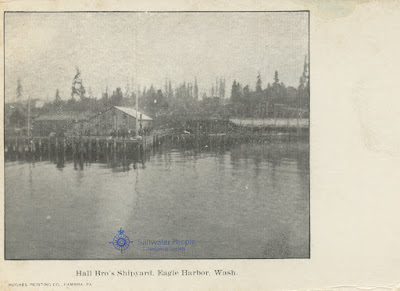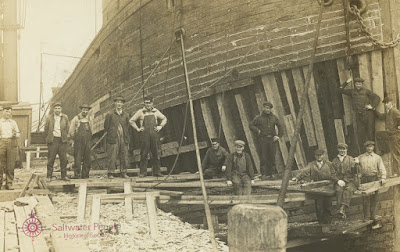 |
Robinson Fisheries Company & Porter Fish Co, Fidalgo Island, Washington. Click image to enlarge. Low res scan of an original antique photo from the Saltwater People Historical Society© |
 |
Robinson Fisheries Company Postcard from the archives of the Saltwater People Log© |
BERING CODFISH FLEET OF 1914
"Schooners AZALEA, WAWONA, and ALICE reach Port in the order named—Robinson Fisheries Flagship Returns with Most Fish Ever Brought Home in an American Bottom.
 |
Eberhardt Bruns (1902-1982), then a resident of Shaw Island, WA. Hanging highest in the rigging, going north on the schooner AZALEA, for Robinson Fisheries, circa 1924. We have Eber's written memories of signing ships' papers as Chief Engineer on a full-rigged schooner with no power. Those can be seen here |
With the arrival of the Robinson Fisheries Company’s schooner ALICE, Capt. John McInnis, in port today with a full catch of Bering Sea codfish, three of the Anacortes fleet are home from the north after one of the best seasons on record in the Pacific. The Matheson Fisheries flagship AZALEA was the first to arrive Tuesday and was followed by the Robinson flagship WAWONA. This was the maiden trip for both the WAWONA and AZALEA and both made good, the WAWONA bringing back a record-breaking cargo.
Distinguishing herself on her maiden voyage as a codfisher by bringing out of the Bering Sea the largest catch of codfish ever brought home in one trip by an American vessel, the Robinson Fisheries schooner WAWONA arrived at her homeport in Anacortes Tuesday night. Her hold was filled to capacity with a catch of 240,000 of the finest fish ever brought out of the Bering. The catch will easily weigh 550 tons.
The ship, which is the largest vessel of the Puget Sound codfish fleet has a catch that exceeds the number of fish ever landed in an American bottom and caught and prepared on the vessel in one trip. This applies to the Atlantic as well as the Pacific coast. Thus Anacortes, the “Gloucester of the Pacific,” has beaten the records of the Atlantic.
Almost all of WAWONA’s cargo was caught in deep water, ranging from 32 to 45 fathoms and almost all of the other vessels caught their fishing shoal water.
The WAWONA made an unusually fast trip, both going and returning. The vessel cleared from Anacortes on 31 March and sighted Sanak Island at the entrance of Unimak Pass and the Bering on 8 April. The past season has been a particularly stormy one, but the fishing was exceptionally good. Owing to rough weather the WAWONA, in common with the other vessels of the fleet was late to start fishing, storm following storm for several weeks. In the gale of 24 May, the WAWONA lost an anchor and 50 fathoms of chain. Shortly after that she went through another storm and lost another anchor and 50 fathoms of chain, leaving the vessel with only one anchor to finish the trip. They depended on this and no further accident happened. The trip was free from any sickness or casualties, and after the weather settled the fishermen made up for lost time.
*Capt. Charles Foss and all of his crew are enthusiastic in praise of their staunch vessel. Capt. Foss declares that the ship would not have been better if she had been built especially for cod fishing. The WAWONA, built for a lumber carrier, was purchased by the Robinson Fisheries company last winter to take the place of the schooner JOSEPH RUSS which was wrecked two seasons previous in northern waters.
*Capt. Charles Foss and all of his crew are enthusiastic in praise of their staunch vessel. Capt. Foss declares that the ship would not have been better if she had been built especially for cod fishing. The WAWONA, built for a lumber carrier, was purchased by the Robinson Fisheries company last winter to take the place of the schooner JOSEPH RUSS which was wrecked two seasons previous in northern waters.
 |
Codfish schooner JOSEPH RUSS on the Bering Sea, Alaska. Click image to enlarge. Low res scan of an original photo from the Saltwater People Historical Society© Photograph by John Thwaites. |
Second mate Emil Isakson was high line with a catch of 17,036. First mate Sam Ostman was second high line with a catch of 16,203 and Chris Norvick was third man with a catch of 14,442. From these figures the individual catches ranged all the way down to 5,000, most of them being 9,000 to 12,000.
The WAWONA arrived in the Straits of Juan de Fuca after a remarkably fast run of ten days from the north. On reaching the straits she became becalmed and being unable to get a towboat, she sailed into Anacortes and arrived at her wharf without the aid of a towboat."
Anacortes American 10 September 1914
Anacortes American 10 September 1914





































